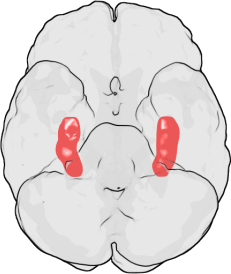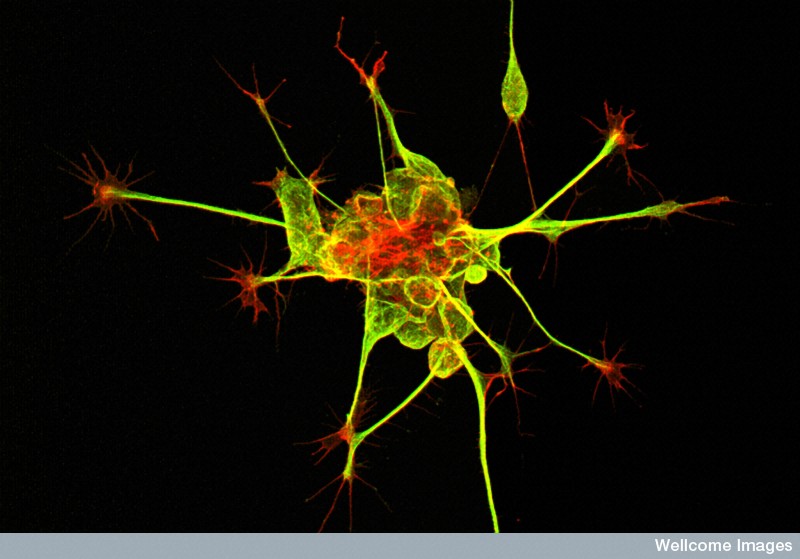Exercise and Interaction for the Brain?
Interview with
Hannah - Can we stimulate new nerve cells to form in our brains, or are we stuck with the number of brain cells that we are born with? We discuss this and the implications with Professor Fred Gage from the Salk Institute, California.
Sound Bite Fred - Many of us believe that the brain is the seat of our awareness or consciousness of knowledge of who we are and the site of all our memories. And if it's changing, and new cells are dividing, how do we have any constancy? How do we have any sense of cells that's retained throughout life?
Hannah - People have estimated that we have about 100 billion nerve cells in our brains with 100 trillion supporting cells and connections. Traditionally, people thought that this number was for life.
But since the 1960s, there has been a growing body of evidence that new nerve cells are born in particular regions of the brain throughout your life, including in the dentate gyrus of the hippocampus - a key brain region important for learning and memory.
This natural birth of new cells in your brain is called neurogenesis and it's in a constant state of flux as Professor Fred Gage from the Salk Institute, California explains...
Fred - Neurogenesis is not a stable phenomenon. It's affected by all kinds of things like learning and exercise, and just how much you stimulate yourself. New, and exciting experiences will increase neurogenesis whereas sedation, high stress levels, and ageing can affect it in a negative way and decrease it. So, everybody is different and it's regulated by experience.
negative way and decrease it. So, everybody is different and it's regulated by experience.
It would be hard to get vast numbers in regular individuals, so it's better controlled in experimental animals where you can control the environment a little better. It turns out that if you take a normal healthy animal and shift them into what we call an enriched environment filled with interesting objects that they can explore, the can move around and burrow, nest. And you leave them in there for 1 month and then you count the number of newly born brain cells. You'll find that there is a dramatic increase in that core of animals compared to genetically identical, gender same, same age, everything exactly the same.
In fact, when you count the total number of neurons in this area, in a mouse, it's about 300,000 neurons. If you put them in a chamber that's a rich environment for a month, you can count 350, 000 cells. So there's a 15% increase or 50,000 new neurons are added to the dentate by virtue of being an enriched environment.
Hannah - That's incredible! And this increase in neurogenesis, this birth of new brain cells when in an enriched environment, this is taking place in adult rodents?
Fred - These were in adult animals. If you take that same paradigm and you used aged animals where you get a decline in neurogenesis, a dramatic decline by an order of magnitude, the enriched environment will increase neurogenesis.
 There's another feature of this and the enriched chambers had running wheels in them and you couldn't really determine whether or not the increase was because of the running wheels, the exercise, or was it because of the enriched environment. So, subsequent experiments were conducted, isolating out just the enrichment from exercise. That turns out that these two experiences have different effects. Normally, when neurogenesis occurs, it takes about a month to 2 months for the cells to fully mature into neurons. And in that process, under, let's say, standard conditions, a fair number of the cells don't make it. Say, 50% or so don't make it. Only about 50% of the cells that are born early on actually survive. But if you put them into the enriched environment, now, nearly 80% of the cells survive. So the increase in neurogenesis that is seen is a result of the survival effect rather than anything else. However, if you just put them into a cage with a running wheel where they have exercise, they voluntarily do this of course, and they actually will work to get a chance to run in the running wheel, that doesn't have much of a survival effect, but it increases the stimulation and the proliferation of the cells. So, the increase in neurogenesis that one sees from exercise appears to be - because of proliferation - whereas the increase from enrichment is for survival.
There's another feature of this and the enriched chambers had running wheels in them and you couldn't really determine whether or not the increase was because of the running wheels, the exercise, or was it because of the enriched environment. So, subsequent experiments were conducted, isolating out just the enrichment from exercise. That turns out that these two experiences have different effects. Normally, when neurogenesis occurs, it takes about a month to 2 months for the cells to fully mature into neurons. And in that process, under, let's say, standard conditions, a fair number of the cells don't make it. Say, 50% or so don't make it. Only about 50% of the cells that are born early on actually survive. But if you put them into the enriched environment, now, nearly 80% of the cells survive. So the increase in neurogenesis that is seen is a result of the survival effect rather than anything else. However, if you just put them into a cage with a running wheel where they have exercise, they voluntarily do this of course, and they actually will work to get a chance to run in the running wheel, that doesn't have much of a survival effect, but it increases the stimulation and the proliferation of the cells. So, the increase in neurogenesis that one sees from exercise appears to be - because of proliferation - whereas the increase from enrichment is for survival.
Hannah - And if this translates to humans. I mean, that's an incredible finding isn't it? If we exercise more and also stimulate ourselves more then we will have new nerve cells being born at a higher rate, and surviving as well?
Fred - That's right. There are a couple o f studies that have looked at this. One is using what's called functional magnetic resonance imaging, which measures basically metabolism and blood flow. And taking humans that have had exercise over a period of 8 weeks were imaged repeatedly, every, I think about every 3 weeks as they exercising. And what was determined was that those subjects that were exercising regularly showed a long term increase in blood glucose utilisation, just in this dentate gyrus where new neurons are being formed. And then it was done both in humans and in mice. In the mice, they could also see this imaging increase in the dentate gyrus. But if you block neurogenesis from coming, you didn't get that increase in the fMRI signal. At least it's correlated both between what's happening in mouse, running or exercise let's say in humans.
f studies that have looked at this. One is using what's called functional magnetic resonance imaging, which measures basically metabolism and blood flow. And taking humans that have had exercise over a period of 8 weeks were imaged repeatedly, every, I think about every 3 weeks as they exercising. And what was determined was that those subjects that were exercising regularly showed a long term increase in blood glucose utilisation, just in this dentate gyrus where new neurons are being formed. And then it was done both in humans and in mice. In the mice, they could also see this imaging increase in the dentate gyrus. But if you block neurogenesis from coming, you didn't get that increase in the fMRI signal. At least it's correlated both between what's happening in mouse, running or exercise let's say in humans.
Hannah - Once these new nerve cells have been born, they also have to survive and they also have to form a fairly functional circuit with the existing neurons as well.
Fred - That's right and I think that's sometimes overlooked because it's so remarkable that these cells are being born alone, but it takes a good 2 months from the time that the cell divides initially from the stem cell to give rise to what we call the neural progenitor cell. To the time that they send out their processes, receive 5,000 connections from their inputs, and then send their axon out to make contact with the target cells, it takes about 2 months to do that and this is a very prescribed pathway where they need to go through certain stages of maturation and it's crucial that the cells are allowed to go through these stages and not rushed through this, in order to make a fully functional cell.
Hannah - And as well as kind of decreasing our stress levels, exercising a bit more, and engaging more with our environment, are there other ways that we can promote neurogenesis or that drugs that we can take?
Fred - You know, this is a very, very hot area of investigation right now where biotech companies and pharmaceutical companies are in the process of developing drugs. I know that there are companies that have drugs at various stages of development for increasing neurogenesis.
Hannah - That was Professor Fred Gage from the Salk Institute, speaking about how exercise and new experiences stimulate the birth of new brain cells.









Comments
Add a comment